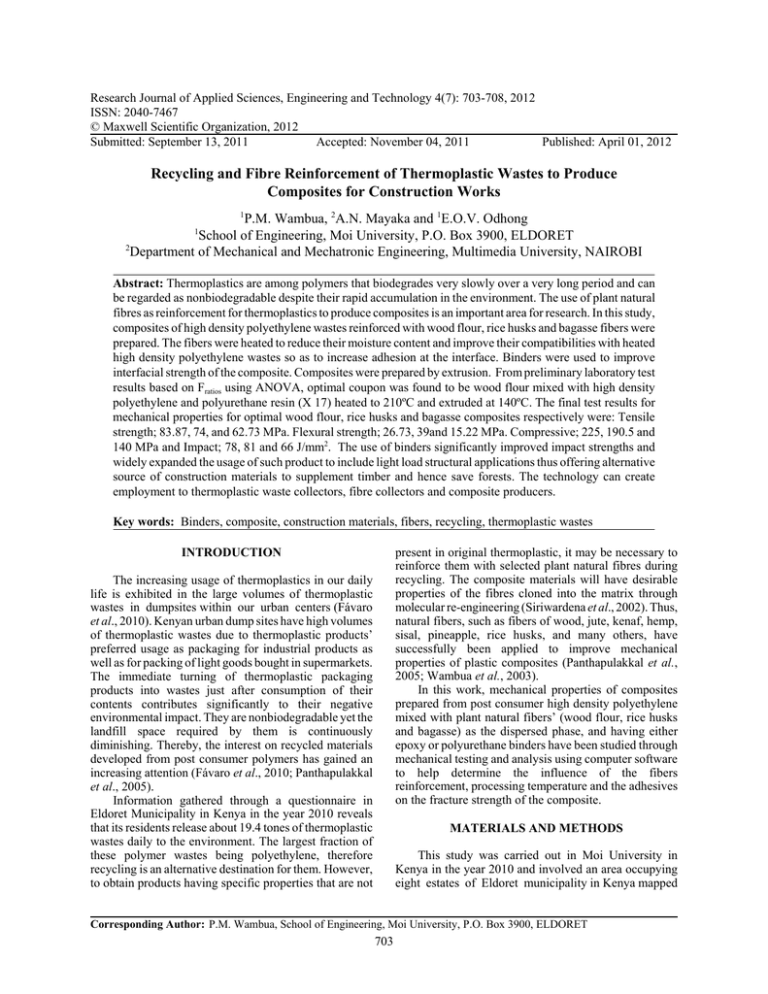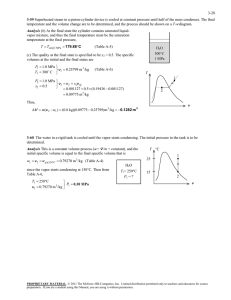Research Journal of Applied Sciences, Engineering and Technology 4(7): 703-708,... ISSN: 2040-7467 © Maxwell Scientific Organization, 2012
advertisement

Research Journal of Applied Sciences, Engineering and Technology 4(7): 703-708, 2012 ISSN: 2040-7467 © Maxwell Scientific Organization, 2012 Submitted: September 13, 2011 Accepted: November 04, 2011 Published: April 01, 2012 Recycling and Fibre Reinforcement of Thermoplastic Wastes to Produce Composites for Construction Works 1 P.M. Wambua, 2A.N. Mayaka and 1E.O.V. Odhong School of Engineering, Moi University, P.O. Box 3900, ELDORET 2 Department of Mechanical and Mechatronic Engineering, Multimedia University, NAIROBI 1 Abstract: Thermoplastics are among polymers that biodegrades very slowly over a very long period and can be regarded as nonbiodegradable despite their rapid accumulation in the environment. The use of plant natural fibres as reinforcement for thermoplastics to produce composites is an important area for research. In this study, composites of high density polyethylene wastes reinforced with wood flour, rice husks and bagasse fibers were prepared. The fibers were heated to reduce their moisture content and improve their compatibilities with heated high density polyethylene wastes so as to increase adhesion at the interface. Binders were used to improve interfacial strength of the composite. Composites were prepared by extrusion. From preliminary laboratory test results based on Fratios using ANOVA, optimal coupon was found to be wood flour mixed with high density polyethylene and polyurethane resin (X 17) heated to 210ºC and extruded at 140ºC. The final test results for mechanical properties for optimal wood flour, rice husks and bagasse composites respectively were: Tensile strength; 83.87, 74, and 62.73 MPa. Flexural strength; 26.73, 39and 15.22 MPa. Compressive; 225, 190.5 and 140 MPa and Impact; 78, 81 and 66 J/mm2. The use of binders significantly improved impact strengths and widely expanded the usage of such product to include light load structural applications thus offering alternative source of construction materials to supplement timber and hence save forests. The technology can create employment to thermoplastic waste collectors, fibre collectors and composite producers. Key words: Binders, composite, construction materials, fibers, recycling, thermoplastic wastes present in original thermoplastic, it may be necessary to reinforce them with selected plant natural fibres during recycling. The composite materials will have desirable properties of the fibres cloned into the matrix through molecular re-engineering (Siriwardena et al., 2002). Thus, natural fibers, such as fibers of wood, jute, kenaf, hemp, sisal, pineapple, rice husks, and many others, have successfully been applied to improve mechanical properties of plastic composites (Panthapulakkal et al., 2005; Wambua et al., 2003). In this work, mechanical properties of composites prepared from post consumer high density polyethylene mixed with plant natural fibers’ (wood flour, rice husks and bagasse) as the dispersed phase, and having either epoxy or polyurethane binders have been studied through mechanical testing and analysis using computer software to help determine the influence of the fibers reinforcement, processing temperature and the adhesives on the fracture strength of the composite. INTRODUCTION The increasing usage of thermoplastics in our daily life is exhibited in the large volumes of thermoplastic wastes in dumpsites within our urban centers (Fávaro et al., 2010). Kenyan urban dump sites have high volumes of thermoplastic wastes due to thermoplastic products’ preferred usage as packaging for industrial products as well as for packing of light goods bought in supermarkets. The immediate turning of thermoplastic packaging products into wastes just after consumption of their contents contributes significantly to their negative environmental impact. They are nonbiodegradable yet the landfill space required by them is continuously diminishing. Thereby, the interest on recycled materials developed from post consumer polymers has gained an increasing attention (Fávaro et al., 2010; Panthapulakkal et al., 2005). Information gathered through a questionnaire in Eldoret Municipality in Kenya in the year 2010 reveals that its residents release about 19.4 tones of thermoplastic wastes daily to the environment. The largest fraction of these polymer wastes being polyethylene, therefore recycling is an alternative destination for them. However, to obtain products having specific properties that are not MATERIALS AND METHODS This study was carried out in Moi University in Kenya in the year 2010 and involved an area occupying eight estates of Eldoret municipality in Kenya mapped Corresponding Author: P.M. Wambua, School of Engineering, Moi University, P.O. Box 3900, ELDORET 703 Res. J. App. Sci. Eng. Technol., 4(7): 703-708, 2012 population who were heads of house-holds and also Estate Managers of firms both chosen purposively from eight estates which were deemed to contain information on thermoplastic wastes (Mugenda and Mugenda, 2003). The data was collected from 400 respondents using a questionnaire. More data was obtained directly from the dumpsites and liter bins in Eldoret municipality. The prevalence per weight fractions of thermoplastic wastes available at the dumpsites and at liter bins in the homesteads and also around enterprises/firms in descending order were as follows: High density polyethylene (HDPE), Polyethylene terephthalate (PET), Polypropylene (PP), Low density polyethylene (LDPE), Polystyrene (PS) and Polyvinyl chloride (PVC). This information is presented in a pie chart (Fig. 1). Waste thermoplastics: High density polyethylene (HDPE) thermoplastic wastes were selected for the study due to their prevalence. The selected HDPE collected from Eldoret municipal dump sites (Fig. 2) were cleaned, dried and shredded to 10 mm by 10 mm size then used for production of composites. The other thermoplastic wastes could be used for batch production in case of full scale production. Fig. 1: Thermoplastic wastes prevalence (by weight) in eldoret municipality through Global Positioning System (GPS) as seen in Fig. 2. The estates were: Huruma, Langas, Elgon View, Milimani, Kapsoya, Mwanzo, Pioneer and West Indies. Questionnaires were administered targeting adult Eloder Municipality Fig. 2: GPS map for areas where HDPE wastes were collected from in eldoret 704 Stress, MPa Res. J. App. Sci. Eng. Technol., 4(7): 703-708, 2012 Fig. 3: Universal mechanical testing machine T1F1B1-fracture stress = 28 MPa T1F1B2-fracture stress = 26 MPa T1F1B3-fracture stress = 31 MPa T1F1B1-fracture stress = 36 MPa T1F1B2-fracture stress = 33 MPa T1F1B3-fracture stress = 40 MPa T1F1B1-fracture stress = 47 MPa T1F1B2-fracture stress = 38 MPa T1F1B3-fracture stress = 47 MPa 50 45 40 35 30 25 20 15 10 5 0 0 Fiber preparation: Plant natural fibers of wood flour, rice husks and bagasse were used as reinforcement material. Bagasse was collected from Chemelil Sugar Company in Kenya. Wood flour was collected from saw mills around Eldoret town and rice husks were collected from Ahero rice mills in Kenya. Fiber preparation included cleaning to remove any impurities and chemicals, hammer milling (for rice husks), and also choosing of the correct sizes of fibre in terms of diameter and length. This was to give the correct aspect ratio which alongside fiber orientation, would also determine the strength of the fiber reinforced composite (Cavalieri and Padella, 2002). The fibers were then completely dried. The fiber length was measured by use of vernier caliper and its thickness was measured by micrometer screw gauge. The size of fibre used for composite production was 1.5 to 5 mm in length and thickness was 0.5 to 0.75 mm. 0.1 0.2 0.3 Strain 0.5 0.4 0.6 Fig. 4: Graphs of compressive stress/strain for composite coupons produced at T1 = 190ºC T2F1B1-fracture stress = 38 MPa T2F1B2-fracture stress = 26 MPa T2F1B3-fracture stress = 42 MPa T2F2B1-fracture stress = 50 MPa T2F2B2-fracture stress = 41 MPa T2F2B3-fracture stress = 71 MPa T2F3B1-fracture stress = 47 MPa T2F3B2-fracture stress = 37 MPa T2F3B3-fracture stress = 55 MPa 80 70 Stress, MPa 60 50 40 30 20 10 0 0 Binders: One part epoxy resin (EP 21 LV) i.e., B1, two part epoxy resin (EP 62-1) i.e., B2 and polyurethane resin (X 17) i.e., B3 were used for production of fibre reinforced composite so as to widen its applications. 0.2 0.6 0.4 0.8 Strain 1.0 1.2 1.4 Fig. 5: Graphs of compressive stress/strain for composite coupons produced at T2 = 210ºC Research instruments, equipment and tools: Research equipment included shredder, extrusion chamber fabricated in Moi University workshop, heating furnace, tongs, extrusion fixture, hand gloves, hacksaw and computer system. A universal mechanical testing machine available in materials laboratory at the Eldoret Polytechnic in Kenya (Fig. 3) was used for compressive strength, tensile and flexural strength tests. Izod machine also available in the same laboratory was used for Impact strength tests. T3F1B1-fracture stress = 38 MPa T3F1B2-fracture stress = 35 MPa T3F1B3-fracture stress = 41 MPa T3F2B1-fracture stress = 52 MPa T3F2B2-fracture stress = 37 MPa T3F2B3-fracture stress = 63 MPa T3F3B1-fracture stress = 58 MPa T3F3B2-fracture stress = 42 MPa T3F3B3-fracture stress = 60 MPa 70 Stress, MPa 60 50 40 30 20 10 0 Production of coupons: A temperature of 190ºC was set on the heating furnace equipment. Shredded mixture of waste thermoplastic and fiber 1 (bagasse), fiber 2 (wood flour) and fiber 3 (rice husks) mixed with binder 1 (one 0 5 10 15 %L 20 25 30 Fig. 6: Graphs of compressive stress/strain for composite coupons produced at T3 = 230ºC 705 Res. J. App. Sci. Eng. Technol., 4(7): 703-708, 2012 Table 1: Impact test results in J/mm2 Temperature --------------------------------------------------------------190ºC 210ºC 230ºC ---------------- ------------------------------------Binders B1 B2 B3 B1 B2 B3 B1 B2 B3 Bagasse, F1 19 25 31 32 28 44 31 25 49 Wood flour, F2 21 28 34 41 37 59 39 30 53 Rice husks, F3 24 30 30 50 43 55 41 34 50 T1F1B3-fracture stress = 140 MPa T2F2B3-fracture stress = 225 MPa T2F3B3-fracture stress = 190.5 MPa 250 Stress, MPa 200 part epoxy resin - EP21LV), binder 2 (two part epoxy resin EP 62-1), binder 3 (one part polyurethane resin - X 17) were prepared in respective ratios by weight of 3.7: 2.1 for waste thermoplastic and bagasse fiber, 3.7: 2.8 for waste thermoplastic and rice husks, 3.7: 3.3 for waste thermoplastic and wood flour. The binder used in each case was 2.5 mL. In each case the mixture was manually filled into the fabricated casing after application of polytetrafluoroethylene mould release on the barrel walls, taken into heating furnace and heated appropriately for each combination to 190ºC for 10 min, the heating was then stopped, furnace cooling was done to 140ºC and then the hot fabricated casing full of the mixture was taken to an extruding fixture where extrusion process was done manually by use of a 5 kg weight that extruded about 204 mm length of extrudate in 10 sec. The air cooled extruded composite products were then cut into the number of test pieces as per the required number of tests i.e., 9 for compressive and 9 for impact tests for every combination of the fibre, binder and processing temperature. The experiment was repeated for temperature of 210ºC and also 230ºC. The fiber reinforced composite coupons produced were coded and arranged for testing. 150 100 50 0 0 5 15 10 20 % change in length 25 30 Fig. 7: Graph of compressive fracture strengths for optimal coupons T2F2B3-Wood flour composite tensile strength T2F1B3-Bagasse composite tensile strength T2F3B3-Rice husks composite tensile strength 250 Stress, MPa 200 150 100 50 0 0 5 10 15 % L 20 25 30 Fig. 8: Tensile fracture strength graphs of optimal coupons The preliminary mechanical test results in Fig. 4, 5 and 6 and Table 1 under 190, 210 and 230ºC were each fed into computer and using excel software for two factor Analysis of variance without replication, the optimal conditions were found to be; optimal processing temperature was 210ºC, optimal binder was X 17 and optimal fiber for reinforcement was wood flour. Optimal coupons from the three reinforcing fibers which were produced at optimal combination of binder and processing temperatures had properties shown in Table 4. RESULTS AND DISCUSSION Data from compressive strength tests: For all the composite coupons produced at processing temperature of 1900ºC, 210ºC and 230ºC, the tests were done using universal mechanical testing machine shown in Fig. 3. The mean values of the test results for 9 tested coupons for every combination of fibre, binder and processing temperatures were used to draw graphs in Fig. 4, 5 and 6, which also shows the mean fracture strengths for the tested coupons. From the fracture strengths, it was possible to identify the optimal production conditions (fiber, binder and processing temperature) which could be used to produce optimal coupons for further tests. Data analysis: The method used for data analysis was ANOVA for a three factor factorial design to analyze data as well as investigate fiber, binder and extrusion (processing) temperature effects on mechanical properties of the composite. The fracture strengths from the 9 tests in each case were grouped into three and mean of each group used in each case for the three factor factorial analysis as opposed to the two factor analysis in which the mean of the nine tests was the one used. Two sets of Anova tables were obtained, one for compressive test results analysis and another for impact test results analysis. F0 were compared with Fcr. F0 were the calculated values from organized raw data while Fcr were the table values in built in the excel software for a given degree of freedom and level of significance. Data from impact tests at three temperature levels using three binders: For all the composite coupons produced at processing temperature of 190, 210 and 230ºC, the tests were done using Izod impact testing machine. Table 1 shows the values of impact fracture stresses in J/mm2 which is an average for 9 tests for coupons produced for every combination of processing temperature, fiber and binder. 706 Res. J. App. Sci. Eng. Technol., 4(7): 703-708, 2012 Table 2: Anova for three factor for compressive test results Sov Fibers, A Binders, B SS 20.81 17.92 df 2 2 MS 10.4 8.96 80.6 69.4 F0 = Fratio 3.174 3.174 Fc r= Fcrit (table) Temp., C 38.4 2 19.2 148.8 3.174 AB 10.9 4 2.73 21.12 2.55 AC 1.56 4 0.39 3 2.55 BC 4.23 4 1.06 12.4 2.55 ABC 8.73 8 1.09 8.4 2.12 Error 6.96 54 0.129 Total 109.5 80 109.5 Table 3: Anova for three factor for impact test results Sov Fibers, A Binders, B SS 7.89 34.27 df 2 2 MS 3.94 17.14 36.19 157.2 F0 = Fratio 3.174 3.174 Fcr = Fcrit (table) Temp., C 23.64 2 11.82 108.42 3.174 AB 3.78 4 0.95 8.67 2.55 AC 1.36 4 0.34 3.11 2.55 BC 6.54 4 1.64 15 2.55 ABC 0.68 8 0.09 0.78 2.12 Error 5.9 54 0.11 Total 84.06 80 Table 4: Various fracture strengths for the optimal coupons Mechanical property tested Optimal waste thermoplastic ---------------------------------------------------------------------------------------------------------------------------------------Tensile strength (MPa) composite Compressive strength (Mpa) Flexural strength (MPa) Impact strength (J/mm2) Wood flour,T2F2B3 225.0 26.73 78 83.87 190.5 39.00 81 74.00 Rice husks, T2F3B3 140.0 15.22 66 62.70 Bagasse, T2F1B3 From Anova Table 2 for compressive strengths at 5 % level of significance, all the calculated Fratio, (F0) were greater than table values (Fcrit) hence in each case we conclude that the fibers, binders and various extrusion temperatures influenced compressive strengths of the composite coupons (Montgomery, 1995). From the large F0 for the temperature, it was concluded that the variation of processing temperature affected the compressive strengths the most (Kothari, 2004). The F0 for the interaction among factors were also greater than Fcrit, hence they also caused variations in the compressive strengths of the composites. As for Anova table for impact strengths (Table 3) the results were as above. It is noted that the binder had most significant influence on impact strengths since the F0 for binder was greater than all the others. Optimal coupons having best possible fiber orientation as well as the correct weight fraction of both matrix and fibre (Wf = 42%) and binder 3 (polyurethane resin or X 17) produced at 210º were tested and the results were as shown in Table 4. As for compressive fracture strengths and tensile fracture strengths, the results were as seen in the Fig. 7 and 8. Wood flour cmposite had the highest compressive and tensile strength while rice husks composite had the highest flexural and impact strengths. From Fig. 7, wood flour composite had 225 MPa as compressive strength, rice husk composite had 190.5 MPa as the compressive strength and bagasse composite had 140 MPa as compressive strength. From Fig. 8, wood flour composite had 83.87 MPa as the tensile strength, rice husks composite had 74 MPa as the tensile strength and bagasse composite had 62.27 as the tensile strength. DISCUSSION The entire process of composite production and use includes composition selection, manufacturing process, property investigation and finally engineering application (Zhang and Friedrich, 2003). As for optimal composite coupons, molecular reengineering enabled cloning of desirable physical and structural properties of fibers into the matrix and the composites finally had superior performance properties than the parent thermoplastic wastes or the reinforcing fiber materials (Siriwardena et al., 2002). The addition of binders chemically substitutes the need for fibre surface modification and therefore enhances interfacial strength. Mechanical interlocks are created at the fiber / matrix interface when the fiber surfaces are roughened through hammer milling or cleared of hydroxyl ions through appropriate thermal preparation by heating. This process also enhances interfacial strength and imparts superior mechanical properties to the composite. Rice husks has some silica content and this aids in the formation of bonds with the polymer which offers higher flexural strengths as well as higher impact strength compared to that of the other reinforcing fibres. Its composite also offers resistance to water absorption and hence most resists rot. This makes rice husks most suitable than the other two fibres as the reinforcement phase for composites to be used as fencing posts which are exposed to wet environment. Wood flour fibre reinforced composite has higher compressive and tensile strengths but it loses its strength faster since wood flour is highly hygroscopic and susceptible to rot (Cooper, 2005). Bagasse fibre reinforced composite suffers from lack of proper adhesion of matrix to fibers since fibers are in bundles and hence this composite has the weakest strength in all cases. Phase migration occurred and affected the mechanical properties 707 Res. J. App. Sci. Eng. Technol., 4(7): 703-708, 2012 thus lowering tensile, flexural and impact strengths in all cases. The use of binders significantly increased impact strengths and provided value addition to thermoplastic wastes which were otherwise destined for land fill or incineration, and they became highly priced as durable composite product after fiber reinforcement during recycling. Due to life cycle advantages during its use (e.g., no need for painting, resists rot, nonhygroscopic), the composite product can fetch higher price per post than ordinary timber. Recycling guarantees elimination of burning of thermoplastic wastes. This means that the toxic gases such as polychlorinated biphenyls which are released to the environment during incineration of thermoplastic wastes are avoided through recycling and reinforcement to produce fibre reinforced composites. With improved impact strengths, the fibre reinforced composites can be used for light load structural applications such as supporting small capacity water tank as stands as well as use as fencing posts for fencing of dams, pans, borehole sites among others. ACKNOWLEDGMENT We acknowledge the assistance offered to us by the head of Mechanical Engineering at the Eldoret Polytechnic (Mr. Kennedy Munyole), in whose institution we got the material testing equipment and tested the coupons. We also highly appreciate the assistance offered to us by head of Mechanical and Production Engineering Department of Moi University (Eng. Isaiah Chebii) for allowing us to use furnaces in the thermodynamics and materials laboratory to produce the fibre reinforced composite coupons. We also thank the Dean, School of Engineering, Moi University (Prof. Kirimi Kiriamiti) for his valuable assistance and support throughout the research period. We are very grateful to the Ministry of Water and Irrigation of Kenya through National Water Conservation and Pipeline Corporation for having sponsored this research. REFERENCES Cavalieri, F. and F. Padella, 2002. Development of composite materials by mechano-chemical treatment of post-consumer plastic waste. Waste Manage., 22: 913-916. Cooper, P., 2005. Methods to determine decay resistance of natural fiber plastic composite. J. Forest Prod., 16(5): 58-81. Fávaro, S., M. Lopes, N.G.de Carvalho, R. Santana and R. Radovanovic, 2010. Chemical, morphological, and mechanical analysis of rice husk/postconsumer polyethylene composites. Appl. Sci. Manuf. Express Polymer Lett. 4(8): 465-473. Kothari, C.R., 2004. Research Methodology-Methods and Techniques. 2nd Edn., New Age International, India. Montgomery, D., 1995. Design and Analysis of Experiments. 6th Edn., Oxford, UK Mugenda, O.M. and A.G. Mugenda, 2003. Research Methods Quantitative and Qualitative Approaches. Acts Press, Nairobi. Panthapulakkal, S., S. Law and M. Sain, 2005: Enhancement of processability of rice husk filled high-density polyethylene composite profiles. J. Thermoplast. Compos., 18: 445-458, DOI: 10.1177/ 0892705705054398. Siriwardena, S., H. Ismail and S. Ishiaku, 2002. Mechanical properties and recyclability of thermoplastic composites of white rice husk ashethylene/propylene/diene terpolymer-polypropylene. J. Plastics, Rubber Compos. 31(4): 167-176. Wambua, P., J. Ivens and I. Verpoest, 2003. Natural fibers: Can they replace glass in fiber reinforced plastics? Compos. Sci. Tech., 63: 1259-1264. Zhang, Z. and K. Friedrich, 2003. Artificial neural networks applied to polymer composites: A review: Compo. Sci. Technol., 69: 2029-2044. CONCLUSION Removal of High density polyethylene through recycling removes 45% by weight of thermoplastic wastes from Eldoret municipality in Fig. 1. The use of binders as well as agricultural residues (fibres) for reinforcement of high density polyethylene wastes improves compressive and impact strengths of the composite and hence widely expands its applications and use. The natural plant fibres are therefore economically utilized through their reinforcing function, though they are fully biodegradable. From the results of Anova for three factor, it can be concluded that the use of binders is very necessary to improve impact strengths of the fibre reinforced composite. Also use of fibers positively influence mechanical properties of fiber reinforced composite. Thus the mechanical properties are sufficient to support their use to supplement timber for construction works such as fencing, scaffolds, tank stands among others. Also, by removal of thermoplastic wastes through recycling, malaria which is a common killer disease in Kenya can be reduced by elimination of stagnant water everywhere on carelessly dumped thermoplastic bags. Therefore reinforcement during recycling and addition of binders to the thermoplastic wastes can create employment for many unemployed youths in Kenya to reduce poverty, rid the environment of thermoplastic wastes and some agricultural residues, reduce malaria and also save timber for fencing so as to conserve forests. The establishment of thermoplastic wastes recycling plants in all municipalities in Kenya to minimize thermoplastic wastes from the environment would be a positive step towards creating economic growth through provision of employment at the same time promoting faster industrial growth. 708





